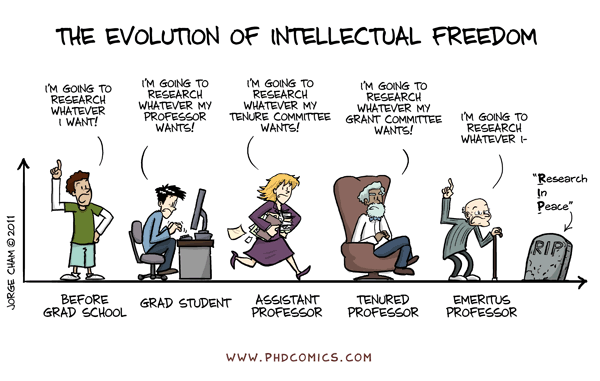The Null Professor - Cristina Lopes
Teaching Computer Science Better to get Better Results - Mark Guzdial
Success in introductory programming: what works? - Porter et al.
Ensino e Investigação
Comentários e referências sobre ensino universitário e investigação.
Escrever em inglês
Writing scientific articles like a native English speaker: top ten tips for Portuguese speakers
How to write a great research paper
Há muitos textos a explicar como escrever artigos, mas este dá muito boas sugestões, é claro e directo:
How to write a great research paper
Simon Peyton Jones - Microsoft Research, Cambridge
How to write a great research paper
Simon Peyton Jones - Microsoft Research, Cambridge
Flipped classroom
The flipped classroom is a pedagogical model in which the typical lecture and homework elements of a course are reversed. Short video lectures are viewed by students at home before the class session, while in-class time is devoted to exercises, projects, or discussions.
http://net.educause.edu/ir/library/pdf/eli7081.pdf
http://net.educause.edu/ir/library/pdf/eli7081.pdf
early-career grad students misconceptions
I’d like to disabuse early-career grad students of certain misconceptions…
Armando Fox
Armando Fox
- You are rarely the best judge of the most important material or best presentation strategy for your talk. Corollary: Give one or more practice talks.
- Writing is much harder than you think. Corollary 1: You are not that great a writer. Corollary 2: If you don’t have a solid draft 1-2 weeks before the conference deadline, you’re starting with 2 strikes.
- 80% or more of submitted papers are rejected. Corollary: You need feedback from colleagues and outsiders to improve your paper. A poor way to get feedback is to submit the paper, wait 6 months, and get a rejection with cryptic reviews. A better way is left as an exercise to the reader. (Thanks to Mike Franklin for this particular way of looking at the “get feedback” issue.)
- When you write up your work, remember that nobody cares what you did but only why it advances the state of the art. Edit accordingly. Corollary: edit an outline and paragraph map before you start writing. It’s much easier to rearrange/eliminate at this level than at the prose level.
- The reviewer has 20 other papers waiting to be reviewed and is looking for a reason to set yours aside and move on. Corollary: your job is to ensure no such opening is provided—whether by unsupported statements, poor writing, rambling style, etc.
- Your goal is not that your work gets the approval of your advisor, but the approval of the research community, as represented by the (usually anonymous) reviewers who will be evaluating your paper. Your advisor can bring her/his experience to bear and give you advice (hence “advisor”) on how to maximize the likelihood of this, but don’t mislead yourself into thinking that your goal should be to please your advisor. If the community is pleased with your work, chances are excellent your advisor will be too. Corollary: Get lots of feedback on a paper from people other than your advisor—i.e., people representative of the reviewers who’ll evaluate it—before submitting it.
Networking on the Network: A Guide to Professional Skills for PhD Students
Networking on the Network:
A Guide to Professional Skills for PhD Students
Phil Agre
Department of Information Studies
University of California
http://vlsicad.ucsd.edu/Research/Advice/network.html
Phil Agre
Department of Information Studies
University of California
http://vlsicad.ucsd.edu/Research/Advice/network.html
Reproducibilidade de resultados
A Nature tomou medidas para reduzir a falta de reproducibilidade de resultados dos resultados de experiências.
Editorial que explica a iniciativa.
Uma checklist muito interessante a ser preenchida pelos autores. P.ex. diz:
Each figure legend should contain, for each panel where they are relevant:
• the exact sample size (n) for each experimental group/condition, given as a number, not a range;
• a description of the sample collection allowing the reader to understand whether the samples represent technical or biological replicates (including how many animals, litters, cultures, etc.);
• a statement of how many times the experiment shown was replicated in the laboratory;
• definitions of statistical methods and measures:
○ very common tests, such as t-test, simple χ2 tests, Wilcoxon and Mann-Whitney tests, can be unambiguously identified by name only, but more complex techniques should be described in the methods section;
○ are tests one-sided or two-sided?
○ are there adjustments for multiple comparisons?
○ statistical test results, e.g., Pvalues;
○ definition of ‘center values’ as median or average;
○ definition of error bars as s.d. or s.e.m.
Editorial que explica a iniciativa.
Uma checklist muito interessante a ser preenchida pelos autores. P.ex. diz:
Each figure legend should contain, for each panel where they are relevant:
• the exact sample size (n) for each experimental group/condition, given as a number, not a range;
• a description of the sample collection allowing the reader to understand whether the samples represent technical or biological replicates (including how many animals, litters, cultures, etc.);
• a statement of how many times the experiment shown was replicated in the laboratory;
• definitions of statistical methods and measures:
○ very common tests, such as t-test, simple χ2 tests, Wilcoxon and Mann-Whitney tests, can be unambiguously identified by name only, but more complex techniques should be described in the methods section;
○ are tests one-sided or two-sided?
○ are there adjustments for multiple comparisons?
○ statistical test results, e.g., Pvalues;
○ definition of ‘center values’ as median or average;
○ definition of error bars as s.d. or s.e.m.
Software is not science
Muito interessante, sobre como a ênfase de um trabalho científico não deve ser no software desenvolvido, mas na real contribuição científica do trabalho.
http://matt-welsh.blogspot.pt/2011/11/software-is-not-science.html
http://matt-welsh.blogspot.pt/2011/11/software-is-not-science.html
Publishing a new idea
O nome diz tudo. A "new idea" neste caso era a criptografia de chave pública.
Publishing a new idea
by Ralph C. Merkle
Subscrever:
Mensagens (Atom)

